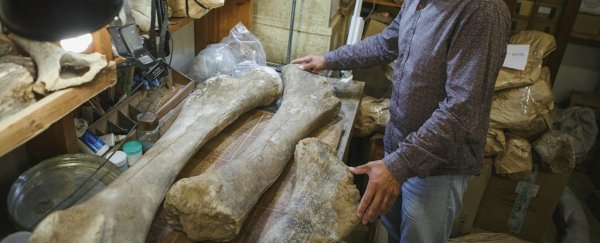Researchers in Russia just uncovered one of the biggest concentrations of mammoth bones ever found, including fossils from eight different individuals, both young and fully grown.
The bones were found in an area known as Wolf Mane, in Russia's Novosibirsk region - a place known to be the largest mammoth graveyard in Eurasia. Now they've set a new record for the amount of mammoth remains found in one place.
In some parts of the 9-square-metre pit, students and researchers from Russia's Tomsk State University ended up uncovering roughly 100 samples per square metre, and not just of mammoths - of all kinds of ancient animals.
In total, they found 785 samples, including the remains of bison, horses, rodents, and what's suspected to be polar foxes.
So far they've only analysed the mammoth bones, though, which were found in sediment at depths of roughly 1.7 to 2.1 metres (5.6 to 6.9 feet) and were only noticed as researchers were wrapping up a previous dig. That means this remarkable discovery almost went completely unnoticed.
"Initially, we opened two bone levels - that is typical for Wolf Mane. We found many interesting instances, and it seemed that there was nothing more," said team member Sergey Leshchinskiy.
"A week later, we were going to go home, but there is an unspoken rule to check the underlying sediments for at least two shovel-depths. We opened one place, then another, and realised that we would have 10 days more to dig."
Besides offering up hundreds of new mammoth samples for study, the team also notes that the extra depth at which the fossils were found has kept the bones extremely well-preserved.
In fact, some of the samples show 'anatomic articulation' - meaning they're intact enough to show how these mammoth bones would have fit and operated together.
These intact mammoth samples will hopefully allow the team to better understand the age of some of the mammoths, their cause of death, size, and other characteristics that are hard to uncover with less preserved samples. And if the same level of preservation is seen in the other animal remains, it could give scientists an overview of the entire ecosystem at the time.
"Among the largest pieces is a thigh with the length of almost 1 metre, 15 centimetres [3 feet, 9.28 inches]," said Leshchinskiy. "Probably, it belonged to a male mammoth aged 45 to 50 years, which weighed 5 to 6 tons or more, and its height with account of the soft tissues exceeded 3 metres [10 feet]."
"Its remains, perhaps, laid in the formation for 20 to 25 or even 30 millennia. We can determine it more precisely with the help of the radiocarbon analysis," he adds.
The team suspects that Wolf Mane became such a large mammoth graveyard because the region's black alkali soil is incredibly rich in minerals not found in other parts of the world.
Superficial analysis of the mammoth bones show evidence of osteodystrophy, suggesting that the animals suffered from a huge mineral deficiency, or 'mineral starvation'. This deficiency is likely what drew the mammoths to such a mineral-rich area, the researchers hypothesise.
No one's sure as yet how the mammoths might have been able to identify these mineral rich areas, but the team suspects there may be thousands more of them preserved underground.
One of the neatest things about Wolf Mane for palaeontologists is the fact that the deeper they dig, the larger the mammoth bones get, providing a rather easy to follow timeline that shows how the species declined by becoming smaller - a sign that the environment could no longer support such massive creatures - over the years prior to its extinction.
So far, the team has yet to publish their find in a peer-reviewed paper, though it will likely come after further analysis of the samples.
Hopefully the finds at Wolf Mane will better our understanding of mammoths, providing us with more details on how they lived, what drew them to Wolf Mane, what their life expectancy was, and what forced them into extinction.
You can see the dig site in the video below (disclaimer: it's in Russian):

